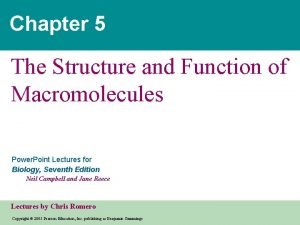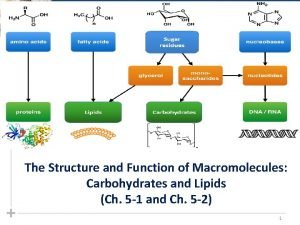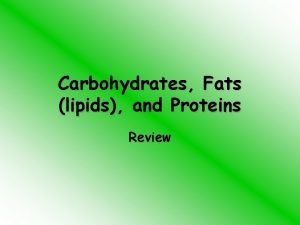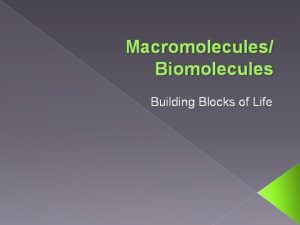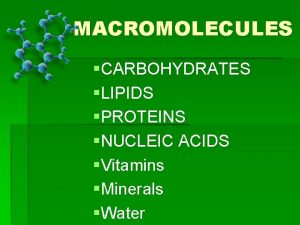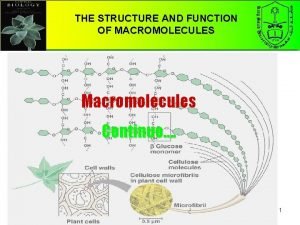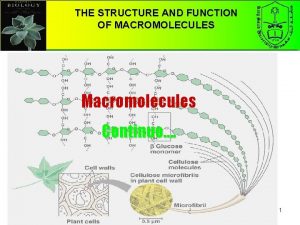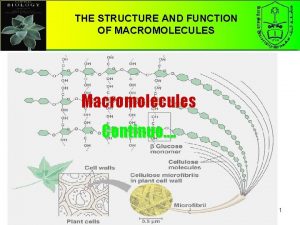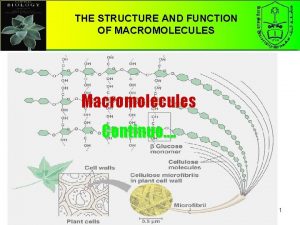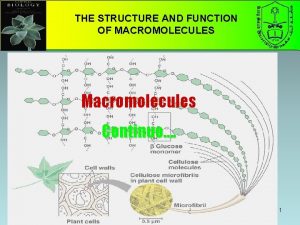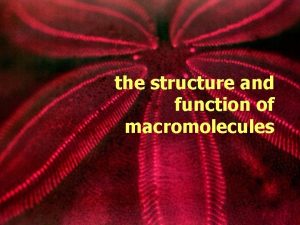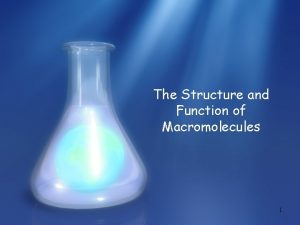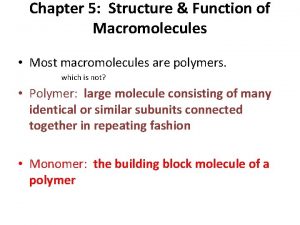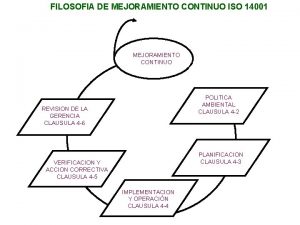THE STRUCTURE AND FUNCTION OF MACROMOLECULES Macromolecules Continuo











- Slides: 11

THE STRUCTURE AND FUNCTION OF MACROMOLECULES Macromolecules Continuo…. 1

2 -Proteins (Polypeptides) Proteins are polymer of amino acids (constructed from 20 amino acids) (to form Polypeptides). There are six functions of proteins: 1. Storage: albumin (egg white) 2. Transport: hemoglobin 3. Regulatory: some hormones 4. Movement: muscles 5. Structural: membranes, hair, nails 6. Enzymes: cellular reactions

- The components of proteins include a hydrogen atom, a carboxyl group, an amino group, and a variable ﻣﺘﻐﻴﺮﺓ R group (or side chain). H General Formula of the Amino Acid: N Amino group H H C R O C OH Carboxyl group Side chain - Differences in R groups produce the 20 different amino acids. Amino acids ﺍﻷﺤﻤﺎﺽ ﺍﻷﻤﻴﻨﻴﺔ v v v Hydrophobic: the amino acids that have hydrophobic R groups (non-polar). Hydrophilic: the amino acids that have polar R groups, making them hydrophilic. Ionized: the amino acids with functional groups that are charged (ionized) at cellular p. H (7). So, some R groups are bases, others are acids.

The Peptide Bond ﺍﻟﺮﺍﺑﻄﺔ ﺍﻟﺒﻴﺒﺘﻴﺪﻳﺔ Peptide bond formed between the carboxyl group of one amino acid and the amino group of the other by dehydration. H N H H O C C OH H R Peptide bond Amino acids Peptide H N H C R O C OH Dehydration ﻧﺰﻉ ﺍﻟﻤﺎﺀ Polypeptide (Protein)

• Amino acids are joined together when a dehydration reaction removes a hydroxyl group from the carboxyl end of one amino acid and a hydrogen from the amino group of another. The resulting covalent bond is called a peptide bond. • • • The repeated sequence (N-C-C) is the polypeptide backbone. Attached to the backbone are the various R groups. Polypeptides range in size from a few monomers to thousands. 5

3 -Lipids; It is the general term for compounds which are not soluble in water 1. Fats store large amounts of energy 2. Phospholipids are major components of cell membranes 3. Steroids include cholesterol and certain hormones 6

Functions of lipids: 1. 2. 3. 4. 5. 6. Long term energy storage Protection against heat loss (insulation) Protection against physical shock Protection against water loss Chemical messengers (hormones) Major component of membranes (phospholipids) Structure of Fatty Acids • • Long chains of mostly carbon and hydrogen atoms with a -COOH group at one end. When they are part of lipids, the fatty acids resemble long flexible tails.

Structure of Fat molecule Glycerol O H OH Ester link H C OH H OH C OH H C C H H H C Fatty Acid H H Dehydration H In a fat, three fatty acids are joined to a single glycerol by an ester linkage, ﺭﺍﺑﻄﺔ ﺇﺳﺘﻴﺮﻳﺔ creating a triacylglycerol.

Types of Fatty acid 1)- Saturated Fats ﺍﻟﺪﻫﻮﻥ ﺍﻟﻤﺸﺒﻌﺔ The Fatty acid components are saturated when there is no double bond between the carbons. All Carbn are linked with Hydrogen. – The Fatty acid components are saturated (there is no double bonds between the carbons. All C are linked with H. – have only single C-C bonds in fatty acid tails – solid at room temp Most animal fats are saturated. – Include most animal fats These double bonds are formed by the removal of H atoms. 2)- Un-saturated Fats ﺍﻟﻐﻴﺮ ﻣﺸﺒﻌﺔ ﺍﻟﺪﻫﻮﻥ – liquid at room temp – one or more double bonds between carbons in the fatty acids allows for “kinks” in the tails – Include most plant fats Most plant fats are unsaturated. They can be synthetically converted to saturated (solid) by adding H (Hydrogenation )ﺍﻟﭽﺓ.

Other lipids have structural, hormonal, or protective functions 1 - Phospholipids: • are the major components of cell membranes Phospholipids have two fatty acids attached to glycerol and a phosphate group at the third position. – The phosphate group carries a negative charge • The fatty acid tails are hydrophobic, but the phosphate group and its attachments form a hydrophilic head. • Thus, it is amphipathic 2. Steroids: are hydrophobic molecules that pass through plasma membranes 3. Waxes: are hydrophobic molecules used for waterproofing 10

Fats (Composed of Lipids) Saturated Unsaturated Animal Fats Vegetable Fats Hydrogenation ـﭽــــﺔ Phospholipids Steroids Bi-layer of cell membrane Sex Hormones & Cholesterol Waxes
 Chapter 5 the structure and function of macromolecules
Chapter 5 the structure and function of macromolecules Biomolecule building blocks
Biomolecule building blocks Micromolecules and macromolecules
Micromolecules and macromolecules What macromolecules are in bread olive oil and pasta
What macromolecules are in bread olive oil and pasta Are monomers building blocks
Are monomers building blocks Site:slidetodoc.com
Site:slidetodoc.com Hát kết hợp bộ gõ cơ thể
Hát kết hợp bộ gõ cơ thể Lp html
Lp html Bổ thể
Bổ thể Tỉ lệ cơ thể trẻ em
Tỉ lệ cơ thể trẻ em Voi kéo gỗ như thế nào
Voi kéo gỗ như thế nào Thang điểm glasgow
Thang điểm glasgow
